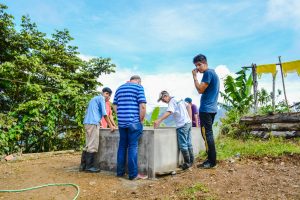Stories on Your Waist and on Your Shoulders

We sat in a coffee house talking, Neto and I. He was telling me about speaking both Quechua and Spanish. Along the way he mentioned a saying that sticks with me still months later. He said that a traveller comes with stories on his waist and on his shoulders.
The person who moves from community to community, like the proverbial Ekeko, the altiplano figure of abundance laden with goods from top to bottom, the traveler appears laden with tales. Part of receiving a traveler is to get them talking, sharing these stories.
People do. They ask where you are from, what kinds of crops they grow in your land, how much things cost. They get you going and encourage you to open your bag that you carry on your waist, if you are traditional, called a ch’uspa, as well as the queperina, the carrying cloth, on your shoulders and let the stories out.
The people of Cuzco, whether Spanish speakers or Quechua speakers tell stories. They have a rich folklore of narrative, some of which is enclosed in Catherine Allen’s amazing book Foxboy. Nevertheless, you will find these stories all over the place, as people talk over chicha, in the bus, or when they meet in lands far from your own. They are stories of the fox and bear, the stars and llamas, and the condenados (kinds of zombies), achanchus (kinds of vampires), and the Christ Child, the Saints and the Virgen.

These stories exist in a space where Andean Catholicism and ancient Andean culture get woven together. Many of them have been collected over the year and fill many pages of books, but they still live where ever people meet.

An eeriness accompanies the traveler. People do not know if the new person is trustworthy or dangerous, if he or she is a real person enmeshed in networks of family and friends or an exploitive person outside of the ordinary life experience of people. As a result, the opening of the cloth and the showing (telling) the gifts the person brings tells a lot about how people are going to interact with them, trust them, or drive them away.
To carry stories on your waist, the middle of your body, is to carry them in a ch’uspa, a woven bag where traditional people normally carry coca leaves. This comparison is very meaningful since coca leaves, like stories, build ties among people when they are shared. They also tie people to the landscape when k’intus (bundles of three) coca leaves are blown to the Apus and huacas, the ancestral land forms and the holy earth shrines.
Carrying the stories on your back, enfolded in a carrying cloth, relates them to the burdens one carries, whether cargo that the traveler carries to trade or sell, or the weight one carries as a good member of society when you take on a cargo, a responsibility, of community governance or feast sponsorship. Stories are like this. They can be exchanged, like both meanings of the word cargo, the burden for the society and the burden of goods to exchange. In both cases you build something greater than self, relationships and communities.

Through stories people learn of far away places and people, they learn to think through how the world works, its powers and dangers. They also compare and interweave. The stories are like skeins of wool that can be re-spun into tighter thread to go into fine weavings or into the experiences people have of life. We all use stories to compare and contrast what we see and know with what others see and know. And, it is in stories where Andean people keep alive their traditions and customs, as they also do in their dances and feasts.
Someday I will see Neto again and help him open his ch’uspa and queperina of stories while he helps me to unburden mine. It may be in a coffee house in Cuzco, or around a wooden table in his sister’s home where coffee cherries slowly ripen to red. There will always be stories.
Did you hear about when fox climbed up to the sky?




